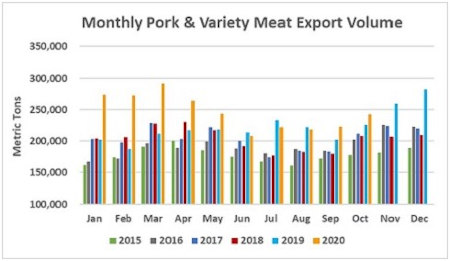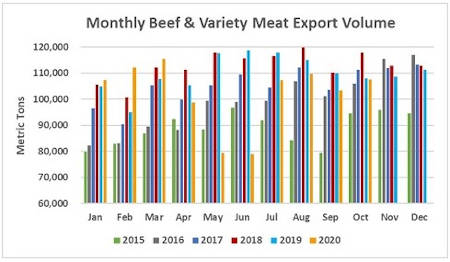U.S. pork exports posted broad-based gains in October, solidifying 2020’s record pace, according to data released by USDA and compiled by the U.S. Meat Export Federation (USMEF). Beef muscle cut exports were also higher than a year ago in October, though lower variety meat volumes pushed total beef exports slightly below last year.
October pork exports were up 8% year-over-year to 242,536 metric tons (mt), with value also increasing 8% to $641.1 million. Through the first 10 months of the year, exports were 15% ahead of last year’s record pace at 2.46 million mt, with value up 16% to $6.33 billion. October muscle cut exports posted double digits gains at 201,723 mt (up 11%), with value up 10% to $551.8 million. This pushed January-October totals for pork muscle cuts to 2.07 million mt (up 20%) valued at $5.49 billion (up 18%).
Pork export value averaged $46.87 per head slaughtered in October, down 3% from a year ago, but the January-October average was still 12% higher at $57.33. Exports accounted for 26% of total pork production in October and 23.2% for muscle cuts only, up from 24% and 20.9%, respectively, a year ago. Through October, exports accounted for 29.2% of total production and 26.5% for muscle cuts, each up significantly from the 2019 ratios of 26% and 22.6%.
October beef exports were slightly lower than a year ago at 107,591 mt (down 0.4%), valued at $646 million (down 0.5%). For January through October, exports trailed last year’s pace by 7% in volume (1.02 million mt) and 8% in value ($6.2 billion). Beef muscle cut exports trended higher than a year ago in October, increasing 5% to 85,445 mt valued at $573.8 million (up 1%). January-October muscle cut exports were 5% below last year in volume (791,694 mt) and 8% lower in value ($5.48 billion).
Beef export value averaged $283.94 per head of fed slaughter in October, steady with last year. The January-October average was $293.99, down 5% from a year ago. Exports accounted for 12.7% of October beef production, down slightly from a year ago. But for muscle cuts only, the percentage increased from 10.5% a year ago to 10.8%. January-October exports accounted for 13.2% of total beef production and 11% for muscle cuts, each down about one-half percentage point from a year ago.
“While the tight labor situation continues to limit the cut and variety meat specifications available for export, red meat demand is strengthening in many critical markets,” said USMEF President and CEO Dan Halstrom. “October exports of bone-in hams, for example, were near the July record and up 50% from a year ago. This has been a volatile year, filled with shifts in consumer preferences and a lot of uncertainty for international buyers. But the U.S. industry has responded positively to these challenges and the demand dynamics for red meat are quite strong as we approach year’s end. When the gains made at retail over the past several months are combined with a stronger foodservice recovery, the prospects for export growth are very promising.”
Pork exports gaining strength in wide range of markets
While China/Hong Kong remains this year’s leading destination for U.S. pork exports, October data showed rising momentum in several key markets. Exports to Japan were the largest since April at 34,854 mt (up 18% from a year ago), valued at $146.9 million (up 20%). These results pushed January-October exports to Japan 4% above last year’s pace in volume (318,962 mt) and 6% higher in value ($1.34 billion). U.S. pork continues to increase its share of Japan’s ground seasoned pork imports, which is now 72% compared to 57% last year. Value of these imports reached $275 million through October, up 51% year-over-year, reflecting tariff reductions in the U.S.-Japan Trade Agreement and strong consumer demand for sausages and other processed pork products.
October pork exports to Mexico were the largest since March at 60,798 mt, up 11% from a year ago, valued at $104.8 million (up 8%). January-October exports to Mexico were still down 6% in volume (551,691 mt) and 12% in value ($895.5 million) from a year ago, but U.S. pork is well-positioned for a strong finish to 2020 in Mexico. Through October, Mexico took 69% of U.S. bone-in ham and shoulder exports with volume of nearly 370,000 mt (up 3% from a year ago). For the third consecutive month, Mexico was the leading volume destination for U.S. pork muscle cuts in October at 50,304 mt, up 14% from a year ago.
Though below 2019 levels, pork exports to Central and South America were also the largest since March. Led by strong performances in Honduras and Panama, October exports to Central America reached 8,853 mt valued at $21.2 million, each down slightly year-over-year. Through October, exports to the region trailed last year’s pace by 2% in both volume (75,637 mt) and value ($182.5 million). A surge in exports to Chile pushed October exports to South America to 12,941 mt (down 7% from a year ago) valued at $30.5 million (down 15%). January-October exports to South America remained 25% below last year’s pace in volume (96,651 mt) and 26% lower in value ($238.7 million), but demand in the region continues to show signs of recovery.
Other January-October highlights for U.S. pork exports include:
- Pork exports to China/Hong Kong remained well above year-ago levels in October but made up a significantly smaller share of total U.S. shipments when compared to totals posted earlier this year. October exports were 70,865 mt, up 16% from a year ago, valued at $157.5 million (up 11%). Through October, exports to China/Hong Kong were 86% above last year’s pace in volume (871,612 mt) and 104% higher in value at just under $2 billion.
- Led by a recent surge in demand in the Philippines and a very strong year in Vietnam, pork exports to the ASEAN were 32% above last year’s pace in volume (67,158 mt) and 44% higher in value ($159.2 million).
- Strong demand in the Dominican Republic and Trinidad and Tobago pushed exports to the Caribbean 5% above last year’s pace at 46,577 mt, while value was steady at $109.5 million. Led by a large increase in retail sales, exports to Trinidad and Tobago (4,760 mt, up 23%) have already exceeded the previous annual record. Trinidad and Tobago has emerged as an especially strong destination for pork variety meat, with shipments up 39% from a year ago to 1,505 mt, valued at $2.6 million (up 45%).
- Pork exports to Canada are on the strongest pace since 2013, with January-October shipments up 7% from a year ago in both volume (189,776 mt) and value ($709 million). This growth comes despite a 4% increase in Canada’s 2020 pork production. However, Canada’s January-October pork exports were up 21% to 1.16 million mt, led by a large increase to China (530,000 mt, +147%).
Beef exports to China soaring; established Asian markets also strong
October beef exports to China climbed to a record 6,831 mt valued at $48.1 million, easily exceeding previous record levels reached in recent months. Through October, exports to China were up 219% in volume (24,709 mt) and 187% in value ($177.7 million) from a year ago, but have been especially strong since China’s foodservice sector rebounded from COVID-19 related restrictions imposed earlier in the year. In Hong Kong, where the foodservice recovery has seen more interruptions, January-October exports were down 5% from a year ago in volume (67,882 mt) and 9% lower in value ($541.4 million).


Beef exports to leading market Japan achieved solid growth in October, topping last year by 10% in volume (23,353 mt) and 8% in value ($146.8 million). Through October, exports to Japan trailed last year’s pace by 2% in both volume (257,083 mt) and value ($1.61 billion). Japan has increased imports of U.S. short plate, largely for use in gyudon beef bowl restaurants which have performed relatively well due to their quick-serve and takeaway nature. But this growth has been partially offset by smaller volumes of chuck and loin cuts that are more reliant on full service, sit-down dining. U.S. market share for Japan’s total beef imports was 43.7% through October, up from 40.5% last year, as Australia’s share declined from 45.5% to 41.2%.
Exports to South Korea were slightly below last October at 19,389 mt, with value down 2% to $135.4 million. January-October exports to Korea were 3% below last year’s record pace at 209,101 mt, while value was down 6% to $1.46 billion. However, chilled exports to Korea were up 29% from last year’s record at 58,370 mt, valued at $554 million (up 27%). U.S. market share for Korea’s chilled beef imports was 64.2% through October, up from 61.7% last year. U.S. market share for total beef imports also increased, climbing from 50.4% last year to 52.9% in 2020.
U.S. beef is also coming off a record year in Taiwan, and could set new highs in 2020. October exports to Taiwan reached 5,877 mt (up 15% from a year ago) valued at $46.7 million (up 9%). Through October, exports exceeded last year’s pace by 2% at 54,162 mt, though value was down 2% to $460.3 million. Chilled exports to Taiwan were up 21% to 22,140 mt, valued at $256 million (up 15%). The U.S. dominates Taiwan’s chilled beef market, capturing a 76% share in 2020.
Other January-October highlights for U.S. beef exports include:
- Although still below year-ago levels, October beef exports to Mexico were the largest since March at 16,783 mt, valued at $71.9 million, reflecting a recent uptick in foodservice demand. Through October, exports to Mexico were 27% below last year at 142,850 mt, valued at $620.6 million (down 32%), but USMEF expects demand to strengthen in coming months as tourism and restaurant traffic rebound.
- Led by a record performance in leading market Guatemala, October beef exports to Central America were 3% higher than a year ago at 1,492 mt, with value up 5% to $8.5 million. Exports to Guatemala reached 819 mt (up 52%), while exports to Costa Rica (312 mt) were the highest since February. Through October, exports to the region still trailed last year by 16% in volume (10,762 mt) and 22% in value ($56.9 million).
- Following a down year in 2019, beef exports to Canada have rebounded significantly. January-October volume was up 11% to 91,477 mt, while value climbed 13% to $618.6 million. Canada’s beef production is down 3% in 2020 and exports (through October) declined 7% to 346,480 mt. Canada’s January-October beef imports increased 28% to 162,000 mt, including strong growth from New Zealand, Uruguay, the European Union and Mexico, as well as from the United States.
- Africa continues to be a bright spot for beef variety meat exports, with January-October volume exceeding last year by 59% at 24,028 mt. Export value was up 56% to $18.1 million, led by excellent growth in South Africa, Cote d’Ivoire, Gabon, Angola and Ethiopia.
Click here to see more...